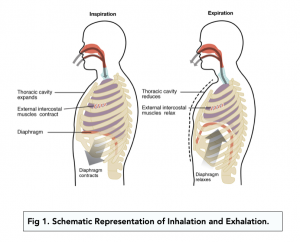Ventilation (A-level Biology)
Ventilation
Ventilation in Mammals
Ventilation is the movement of air into and out of the thoracic cavity.
The thorax (chest) is made up of a ribcage, which houses the lungs and heart.
During inhalation and exhalation, the thoracic cavity expands and contracts. Expansion and contraction allows for changes in air pressure which are crucial for breathing.
Expansion and contraction of the chest cavity is regulated by two sets of muscles: the diaphragm and the (interval and external) intercostal muscles.
Inhalation
The process of inhalation is active, as it requires energy. The route is outlined as follows:
- The diaphragm and external intercostal muscles contract.
- This causes the chest wall (rib cage) to move upwards and outwards as the diaphragm flattens, and so the thoracic cavity expands.
- As the volume of the thoracic cavity rises, the lung pressure decreases below atmospheric pressure.
- Atmospheric air is drawn into the lungs down the pressure gradient, via the trachea.
Exhalation
The process of exhalation is passive as it doesn’t require energy. It is outlined as follows:
- During exhalation, both the diaphragm and external intercostal muscles relax.
- This relaxation causes the chest cavity to contract, which increases the air pressure in the chest cavity, causing the diaphragm to curve.
- As the volume of the thoracic cavity falls, the pressure rises above atmospheric pressure.
- Atmospheric air moves out of the lungs, down the pressure gradient.
Expiration can be forced (e.g., blowing out birthday candles). Forced expiration contracts the internal intercostal muscles to be able to pull the ribcage down and in.

Boyle’s Law states that volume is inversely proportional to pressure in a closed area. This is shown in the table below:

Ventilation in biology refers to the movement of air into and out of the lungs to supply oxygen to the body and remove carbon dioxide. This process is essential for maintaining proper respiratory function and exchanging gases between the body and the environment.
Ventilation in the respiratory system involves the contraction and relaxation of the diaphragm and intercostal muscles, which changes the volume of the thoracic cavity and allows air to flow into and out of the lungs. Air is drawn into the lungs when the diaphragm and intercostal muscles contract, creating a negative pressure within the thoracic cavity. Air then flows into the lungs to equalize the pressure, and the diaphragm and intercostal muscles relax, expelling air from the lungs.
There are two types of ventilation: tidal and minute ventilation. Tidal ventilation refers to the volume of air that is exchanged with each breath, while minute ventilation refers to the total volume of air exchanged in a minute. Both types of ventilation can be influenced by factors such as age, exercise, and disease.
Ventilation is affected by various factors, including age, exercise, and disease. The efficiency of ventilation can be impaired by conditions such as lung disease, chest injury, or neurological disorders, leading to decreased oxygen exchange and respiratory failure.
During exercise, ventilation increases to meet the increased demand for oxygen by the body’s tissues. This increase in ventilation is achieved through increased breathing frequency and tidal volume, which increases the amount of air exchanged in a minute.
Respiratory distress syndrome (RDS) is a condition that affects newborns and is characterized by a failure of the lungs to properly exchange gases. This can lead to hypoxia (low levels of oxygen in the body) and respiratory failure. RDS is often caused by a lack of surfactant, a substance that helps to reduce the surface tension in the lungs and maintain proper ventilation.
Ventilation can be improved by maintaining a healthy lifestyle, including regular exercise and a balanced diet. Conditions such as lung disease or chest injury can also be treated with medications, breathing exercises, and, in severe cases, supplemental oxygen. In some cases, ventilation can be improved through surgical intervention, such as lung transplantation.






Still got a question? Leave a comment
Leave a comment